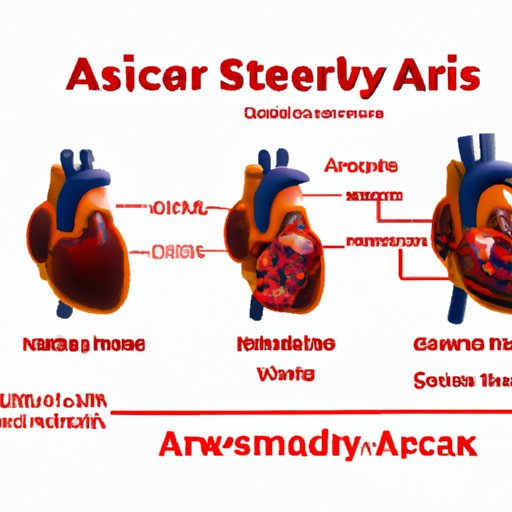Introduction
Abdominal aortic aneurysms (AAA) are a serious condition in which the walls of the aorta, the largest artery in the body, become weakened and bulge outward. This can result in complications such as blood clots, ruptures, and even death. While there are many potential causes of AAA, it is important to understand the underlying cause in order to prevent or manage the condition.
In this article, we will explore the most common cause of abdominal aortic aneurysm, which is atherosclerosis. We will examine how atherosclerosis affects the aorta and the risk factors associated with it, such as hypertension, smoking, and genetics.

Exploring the Causes of Abdominal Aortic Aneurysms
There are several potential causes of abdominal aortic aneurysms, including atherosclerosis, hypertension, smoking, and genetics. Let’s take a closer look at each of these factors.
Atherosclerosis
Atherosclerosis is the buildup of fatty deposits on the inner walls of arteries. Over time, these deposits can harden and narrow the arteries, reducing blood flow and increasing the risk of blood clots. Atherosclerosis is often caused by high cholesterol levels, diabetes, obesity, and a sedentary lifestyle.
Hypertension
High blood pressure, or hypertension, is another major risk factor for abdominal aortic aneurysms. Hypertension increases the pressure inside the arteries, weakening the walls and causing them to bulge outward. People with untreated or uncontrolled hypertension are at a higher risk of developing an abdominal aortic aneurysm.
Smoking
Smoking is another risk factor for abdominal aortic aneurysms. The chemicals in cigarettes damage the walls of the arteries, making them more prone to aneurysms. Additionally, smoking makes it harder for the body to repair damaged tissues, which can make it more difficult to treat an existing aneurysm.
Genetic Factors
Genetics can also play a role in the development of abdominal aortic aneurysms. Certain gene mutations can make people more likely to develop an aneurysm. Additionally, some people may be born with weak aortic walls, which can increase their risk of developing an aneurysm.

The Main Culprit Behind Abdominal Aortic Aneurysms
Of all the potential causes of abdominal aortic aneurysms, atherosclerosis is the most common. It is estimated that up to 70 percent of abdominal aortic aneurysms are caused by atherosclerosis.

Examining the Most Common Cause of Abdominal Aortic Aneurysms
Atherosclerosis is caused by the buildup of fatty deposits on the inner walls of arteries. As these deposits build up, they can harden and narrow the arteries, reducing blood flow and increasing the risk of blood clots. When this happens in the aorta, it can weaken the walls of the artery and cause an aneurysm.
There are several risk factors associated with atherosclerosis, including high cholesterol levels, diabetes, obesity, and a sedentary lifestyle. All of these factors can contribute to the buildup of fatty deposits on the walls of the arteries, increasing the risk of an abdominal aortic aneurysm.
Uncovering the Risk Factors for Abdominal Aortic Aneurysms
In addition to atherosclerosis, there are several other risk factors for abdominal aortic aneurysms. These include hypertension, smoking, and genetics.
Hypertension
High blood pressure, or hypertension, is a major risk factor for abdominal aortic aneurysms. Hypertension increases the pressure inside the arteries, weakening the walls and causing them to bulge outward. People with untreated or uncontrolled hypertension are at a higher risk of developing an abdominal aortic aneurysm.
Smoking
Smoking is another major risk factor for abdominal aortic aneurysms. The chemicals in cigarettes damage the walls of the arteries, making them more prone to aneurysms. Additionally, smoking makes it harder for the body to repair damaged tissues, which can make it more difficult to treat an existing aneurysm.
Genetics
Genetics can also play a role in the development of abdominal aortic aneurysms. Certain gene mutations can make people more likely to develop an aneurysm. Additionally, some people may be born with weak aortic walls, which can increase their risk of developing an aneurysm.
An Overview of the Most Common Cause of Abdominal Aortic Aneurysms
Atherosclerosis is the most common cause of abdominal aortic aneurysms. It is caused by the buildup of fatty deposits on the inner walls of arteries, which can harden and narrow the arteries, reducing blood flow and increasing the risk of blood clots. There are several risk factors associated with atherosclerosis, including high cholesterol levels, diabetes, obesity, and a sedentary lifestyle.
Understanding the Relationship Between Genetics and Abdominal Aortic Aneurysms
Genetics can also play a role in the development of abdominal aortic aneurysms. Certain gene mutations can make people more likely to develop an aneurysm. Additionally, some people may be born with weak aortic walls, which can increase their risk of developing an aneurysm.
It is important to remember that, while genetics can play a role in the development of abdominal aortic aneurysms, lifestyle modifications can help reduce the risk. Eating a healthy diet, exercising regularly, quitting smoking, and managing chronic medical conditions such as diabetes and hypertension can all help reduce the risk of an aneurysm.
Conclusion
In conclusion, atherosclerosis is the most common cause of abdominal aortic aneurysms. It is caused by the buildup of fatty deposits on the inner walls of arteries, which can harden and narrow the arteries, reducing blood flow and increasing the risk of blood clots. Hypertension, smoking, and genetics can also increase the risk of an aneurysm. Lifestyle modifications such as eating a healthy diet, exercising regularly, and quitting smoking can help reduce the risk of an aneurysm.
If you have any concerns about your risk of developing an abdominal aortic aneurysm, it is important to speak to your doctor. They can assess your risk and provide advice on how to reduce it.


